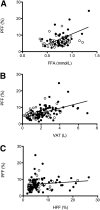Ethnic differences in pancreatic fat accumulation and its relationship with other fat depots and inflammatory markers
- PMID: 21270204
- PMCID: PMC3024373
- DOI: 10.2337/dc10-0760
Ethnic differences in pancreatic fat accumulation and its relationship with other fat depots and inflammatory markers
Abstract
Objective: Visceral adipose tissue (VAT) and hepatic fat are associated with insulin resistance and vary by sex and ethnicity. Recently, pancreatic fat fraction (PFF) has also been linked with increasing obesity. Our aim was to assess ethnic and sex differences in PFF and its relationship to other fat depots, circulating free fatty acids (FFA), insulin secretion and sensitivity, and inflammation in obese adolescents and young adults.
Research design and methods: We examined 138 (40 males, 98 females) obese Hispanics and African Americans (13-25 years). Subcutaneous adipose tissue and VAT volumes, hepatic fat fraction (HFF), and PFF were determined by magnetic resonance imaging. Insulin sensitivity and β-cell function were assessed during an intravenous glucose tolerance test.
Results: Hispanics had higher PFF than African Americans (7.3 ± 3.8 vs. 6.2 ± 2.6%, P = 0.03); this ethnic difference was higher in young adults compared with children and adolescents (ethnicity × age: P = 0.01). Males had higher PFF than females (P < 0.0001). PFF was positively correlated with VAT (r = 0.45, P < 0.0001), HFF (r = 0.29, P < 0.0001), and FFA (r = 0.32, P = 0.001). PFF positively correlated with inflammatory markers but lost significance when adjusted for VAT. In multiple stepwise regression analysis, VAT and FFA were the best predictors of PFF (adjusted R(2) = 0.40). There were no significant correlations between PFF and markers of insulin sensitivity or β-cell function.
Conclusions: PFF is higher in Hispanics than African Americans, and this difference increases with age. In young obese individuals, PFF is related to VAT, HFF, and circulating FFA, thus possibly contributing to their increased risk for type 2 diabetes and related metabolic disorders.
Trial registration: ClinicalTrials.gov NCT00697580.
Figures


References
-
- Després JP, Lemieux I. Abdominal obesity and metabolic syndrome. Nature 2006;444:881–887 - PubMed
-
- Virkamäki A, Korsheninnikova E, Seppälä-Lindroos A, et al. Intramyocellular lipid is associated with resistance to in vivo insulin actions on glucose uptake, antilipolysis, and early insulin signaling pathways in human skeletal muscle. Diabetes 2001;50:2337–2343 - PubMed
-
- Samuel VT, Liu ZX, Qu X, et al. Mechanism of hepatic insulin resistance in non-alcoholic fatty liver disease. J Biol Chem 2004;279:32345–32353 - PubMed
-
- Tilg H, Moschen AR. Insulin resistance, inflammation, and non-alcoholic fatty liver disease. Trends Endocrinol Metab 2008;19:371–379 - PubMed

